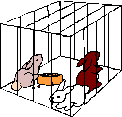
Choosing Your Rabbit
Who Lives With Who?
Housing
Feeding
Handling
Breeding
Pregnancy
The New Litter
Surrogacy
Hand-Rearing
Health
Vets Bills
Pictures
 Rabbit Housing
Rabbit Housing
Hutches
Rabbit
hutches can be bought from most pet shops or if you are adventurous enough you
could try building your own, but make sure that you get one with a weatherproof
roof if the hutch is to be kept out in the open. The hutch should be divided into two parts – two thirds of
it a screened-in open part (usually covered with wire mesh) and one-third a
closed-in bedroom. The enclosed ‘bedroom’ is particularly important if you
are going to be breeding from your doe.
You may be able to pick up a second-hand hutch a lot cheaper by looking in your local newspapers or on-line at auction sites.
The hutch should be situated at least 0.6 m off the ground (outdoor hutches usually come on legs) to protect it from rising damp, rats and other predators and the roof should be sloping so that water will run off it. For added protection, canvas flaps can be attached to all four sides and lowered when the weather is bad.
Ideally the roof should be hinged so that you can gain full access for cleaning the hutch out but some have front opening doors that are equally as good. The doors should have well fitted hinges and catches.
The minimum size of a hutch for a small or medium-sized rabbit is about 4 feet in size (120cm or 48"). Make sure they get plenty of room to move around in.
Enclosures
You need to provide your rabbit with a home that is not only safe but allows them some freedom to exercise, dig, graze and explore. No matter how highly bred a rabbit may be, in biology and in habit they remain very close to the wild.
Consequently the great challenge facing rabbit owners is how to provide safe yet stimulating surroundings for their pets. Probably the best solution is to site the rabbit hutch within a safe enclosure.
During the day the hutch door can be left open, and by the use of a ramp, or a flight of steps, the rabbits can be left free to come and go, as they like. I would not leave your rabbit unattended all day, however, as you never know when another animal will come into the garden and see you pet bunny as its next meal. I only used to let mine out when I was around to keep an eye on them. At night they should be looked away in a secure hutch.
Sometimes the entire garden can be used as the enclosure, being safely walled, or fenced, and so laid out that all-round observation is possible. This may not be possible if you have fences that the rabbit can escape under and the garden is not entirely enclosed. It may then be necessary to partition off a section (I partitioned off the top of my garden as it was enclosed and safe). You should be able to find an area in your garden that quite probably has some existing feature, such as a wall, that can be incorporated into the enclosure. New fencing will need to be at least 1m/1yd high - higher if it also has to keep dogs out - and sunk into the ground to prevent escape by burrowing. Don’t forget that rabbits usually live in burrows so they will instinctively dig holes!
You may also be able to enclose a paved area, and there are the added advantages of having a surface that can be sluiced down quickly, and one that soon dries after rain. It seems cruel, nevertheless, to deprive rabbits of all contact with the earth. Either allow periods of free exercise in the garden, or use a paved enclosure in conjunction with a portable exercise run.
Bedding
I would lay newspaper on the bottom of the cage, then sawdust on top of this to soak up the urine. You can also use cat litter or wood chippings but these will be more expensive than a bag of sawdust. A cheaper alternative is shredded paper which you can probably get free from work!
On top of this you should lay straw and/or hay. I always put hay in the sleeping compartment as it is softer to lay on and a mixture of hay and straw in the outside compartment.
You will soon find that the rabbit will use a particular corner of the cage as its toilet so you could put more newspaper and sawdust in this area.
Eating/Drinking
Utensils
Rabbits need a constant supply of cold fresh water. This should be supplied in a drinking bottle that is attached to the outside of the cage through the wire mesh. These bottles are readily available at any pet store. Water provided in pots will quickly get spilled and soiled so is not advisable. The water should be changed daily and more often in hot weather as it will quickly get warm. Don’t forget in the winter that the water may freeze so you will need to ‘defrost’ the bottle (sometimes more than once a day).
Food
dishes should ideally be heavy earthenware
ones which can be scaled between feeds and which are not easily overturned.
Plastic pots are much less satisfactory.
Rabbits tended to play with them and gnaw them, especially when the
rabbits are confined to the hutch and are suffering boredom.
You
may also like to supply a hay rack which is attached to the inside of the mesh
door and allows the rabbits to eat fresh hay when they wish.